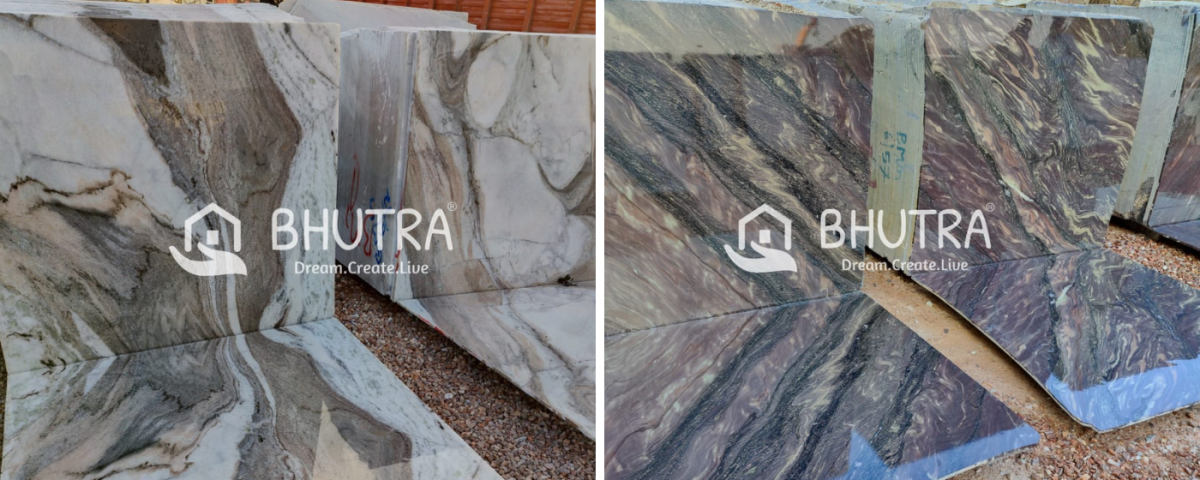Top 10 Best Indian Marble For Flooring

Quartzite Stone at Best Price in India
December 2, 2023
Top 10 World Famous Indian White Marble
December 5, 2023Indian marble is a popular choice for flooring due to its wide variety of colors, textures, and cost-effectiveness. In this article, we will explore the top 10 best Indian marbles for flooring, their characteristics, and the factors to consider when choosing the right marble for your space.
Introduction to Indian Marble
Marble is a natural stone that has been used for centuries in various architectural and decorative applications. Indian marble is known for its exquisite designs, intricate motifs, and timeless elegance. It is available in a wide variety of colors and textures, making it a versatile choice for flooring.
Characteristics of Indian Marble
Indian marble is a relatively harder stone with a medium lustre. It is a cost-effective choice and is available in various thicknesses, making it suitable for different applications, including flooring. Indian marble is also known for its sustainability, making it an environmentally friendly choice for your space.
Top 10 Best Indian Marbles for Flooring
- Makrana Marble: Lustrous white Makrana marble is famously used in the Taj Mahal and is known for its high quality and durability.
- Ambaji Marble: High-quality white Ambaji marble is another popular choice for flooring due to its elegant look and sustainability.
- Rajnagar Marble: This white marble is known for its fine texture and is a popular choice for flooring in India.
- Kishangarh Marble: Kishangarh marble is available in various colors and textures, making it a versatile choice for flooring.
- Katni Marble: Katni marble is known for its smooth texture and is a popular choice for flooring in residential and commercial spaces.
- Morwad Marble: This white marble is known for its purity and is a popular choice for flooring due to its elegant look and durability.
- Jaisalmer Yellow Marble: This yellow marble is known for its unique color and is a popular choice for flooring in India.
- Udaipur Green Marble: This green marble is known for its unique color and is a popular choice for flooring in residential and commercial spaces.
- Makrana Pure White Marble: This pure white marble is known for its high quality and is a popular choice for flooring in India.
- Albeta White Marble: This white marble is known for its elegant look and is a popular choice for flooring in residential and commercial spaces.
Factors to Consider When Choosing Indian Marble for Flooring
When choosing Indian marble for flooring, there are several factors to consider, including the color, texture, durability, and cost of the marble. It is also important to consider the maintenance requirements of the marble, as some varieties may require more maintenance to keep them looking their best.
Maintenance of Indian Marble Flooring
Once you have chosen and installed your Indian marble flooring, it is important to understand the maintenance required to keep it looking its best. Regular cleaning and sealing are essential to preserve the beauty and longevity of the marble.
In this section, we will discuss the best practices for maintaining Indian marble flooring, including cleaning methods, sealing, and common maintenance issues.
Cleaning Methods
Indian marble flooring should be regularly cleaned to remove dust, dirt, and other debris that can scratch the surface. It is important to use a soft, non-abrasive mop or cloth and a pH-neutral cleaner to avoid damaging the marble.
Avoid using harsh chemicals or acidic cleaners, as these can etch the surface of the marble and cause permanent damage.
Sealing
Sealing your Indian marble flooring is essential to protect it from stains and moisture. A high-quality, penetrating sealer should be applied to the surface of the marble to create a protective barrier.
The frequency of sealing will depend on the type of marble and the amount of foot traffic it receives. It is important to follow the manufacturer’s recommendations for sealing to ensure the best results.
Common Maintenance Issues
Indian marble flooring is relatively low-maintenance, but there are some common issues that may arise over time. Scratches, etching, and staining are the most common problems with marble flooring.
Scratches can be minimized by placing felt pads on furniture legs and using area rugs in high-traffic areas. Etching can be caused by acidic spills, such as wine or citrus juice, and should be cleaned up immediately to avoid damage to the marble. Stains can be prevented by promptly cleaning up spills and using coasters under glasses and bottles.
Cost of Indian Marble Flooring
The cost of Indian marble flooring can vary widely depending on the type of marble, the quality, and the size of the area to be covered. In this section, we will discuss the factors that influence the cost of Indian marble flooring, as well as provide some general pricing guidelines.
Factors Influencing Cost
The cost of Indian marble flooring is influenced by several factors, including the type of marble, the quality, the size of the area to be covered, and the installation method.
Rare and high-quality marbles, such as Makrana and Ambaji, will be more expensive than more common varieties. The size of the area to be covered will also impact the cost, as larger areas will require more marble and more labor for installation.
General Pricing Guidelines
As a general guideline, the cost of Indian marble flooring can range from INR 50 to 150 per square foot for materials, with installation costs ranging from INR 100 to INR 250 per square foot.
This means that the total cost of Indian marble flooring can range from INR 75 to INR 225 per square foot, depending on the factors mentioned above.
It is important to obtain quotes from several reputable suppliers and contractors to ensure that you are getting the best price for your project.
Environmental Impact of Indian Marble
Indian marble is a natural stone that is quarried from the earth, and as such, it has an environmental impact. In this section, we will discuss the environmental impact of Indian marble, including the quarrying process, transportation, and sustainability considerations.
Quarrying Process
The quarrying of Indian marble involves the use of heavy machinery and explosives to extract the stone from the earth. This process can have a significant impact on the surrounding environment, including deforestation, soil erosion, and habitat destruction. It is important to choose suppliers that practice responsible quarrying and reclamation to minimize the environmental impact of the marble.
Transportation
The transportation of Indian marble from the quarry to the processing facility and then to the customer’s location also has an environmental impact. The use of fossil fuels in trucks and other vehicles can contribute to air pollution and greenhouse gas emissions.
It is important to choose suppliers that are located close to the quarry to minimize the environmental impact of transportation.
Sustainability Considerations
Despite the environmental impact of Indian marble, it is considered a relatively sustainable building material. Marble is a natural stone that is recyclable and can last for centuries with proper care.
Additionally, many suppliers are implementing sustainable practices, such as water recycling and energy-efficient processing, to minimize the environmental impact of their operations.
Conclusion
Indian marble is a popular choice for flooring due to its wide variety of colors, textures, and cost-effectiveness. By considering the characteristics and factors to consider when choosing Indian marble for flooring, you can select the right marble for your space that meets your aesthetic and practical needs.
Whether you prefer a lustrous white marble like Makrana or a unique colored marble like Jaisalmer Yellow, there is a wide variety of Indian marbles to choose from for your flooring needs.
FAQs
Q1: Is Indian marble suitable for high-traffic areas?
Yes, Indian marble is a durable and long-lasting material, making it suitable for high-traffic areas such as hallways, entryways, and living rooms. However, it is important to choose a high-quality marble and properly maintain it to ensure longevity.
Q2: Does Indian marble require special maintenance?
Indian marble requires regular cleaning and sealing to maintain its beauty and longevity. It is important to use a soft, non-abrasive mop or cloth and a pH-neutral cleaner to avoid damaging the marble. Additionally, sealing the marble will protect it from stains and moisture.
Q3: What is the cost of Indian marble flooring?
The cost of Indian marble flooring can vary depending on the type of marble, the quality, and the size of the area to be covered. As a general guideline, the cost of Indian marble flooring can range from INR 50 to 150 per square foot, including materials and installation.
Q4: Is Indian marble environmentally friendly?
Indian marble is a natural stone that is relatively sustainable. Many suppliers practice responsible quarrying and reclamation to minimize the environmental impact of the marble. Additionally, marble is a recyclable material that can last for centuries with proper care.
Q5: Can Indian marble be used in bathrooms and kitchens?
Yes, Indian marble can be used in bathrooms and kitchens. However, it is important to properly seal the marble to protect it from moisture and stains. Additionally, it is important to clean up spills promptly to avoid damage to the marble.
Q6: How do I choose the right Indian marble for my space?
When choosing Indian marble for your space, consider factors such as the color, texture, durability, and cost of the marble. It is also important to consider the maintenance requirements and environmental impact of the marble. Additionally, obtain samples and compare them in your space to ensure the best fit.





 WhatsApp
WhatsApp